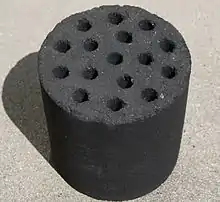| East Asian coal briquettes | |||||||||
|---|---|---|---|---|---|---|---|---|---|
 | |||||||||
| Japanese name | |||||||||
| Kanji | 煉炭/練炭 | ||||||||
| Kana | れんたん | ||||||||
| |||||||||
| Chinese name | |||||||||
| Traditional Chinese | 蜂窩煤 | ||||||||
| Simplified Chinese | 蜂窝煤 | ||||||||
| Literal meaning | Beehive coal | ||||||||
| |||||||||
| Korean name | |||||||||
| Hangul | 연탄 | ||||||||
| Hanja | 練炭 | ||||||||
| Literal meaning | Kneaded coal | ||||||||
| |||||||||
| North Korean name | |||||||||
| Chosŏn'gŭl | 련탄 | ||||||||
Asian coal briquettes (Japanese: 練炭, Hepburn: rentan), also known by the names yeontan (Korean: 연탄) or fēngwōméi (Chinese: 蜂窩煤; Chinese: 蜂窝煤), are coal briquettes used across East Asia for home cooking and residential home heating purposes. They were first invented in Japan, then propagated through the rest of East Asia in the early 20th century, although they are now uncommon in Japan and South Korea.
Made from a mixture of lignite coal dust and a gluing agent that keeps the dust particles together,[1] they became a popular alternative to firewood and natural coal because they come in a consistent size and stack easily. There are 5 standard sizes for the briquettes, and the 2nd standard is widely used in households.
The 2nd standard briquette is cylindrical in shape, weighs 3.5 kilograms (7.7 lb), and is about 20 cm (7.9 in) in height and 15 cm (5.9 in) in diameter. The standard briquette has 22 holes drilled into its top to facilitate steady, efficient burning, and a household typically uses one to three briquettes per day in the winter. A new briquette can be placed on one that has been burned halfway to extend the burn time.
In older South Korean homes, the same fire used for cooking also serves to heat the house, through a radiant underfloor heating system called ondol.
History by region
Korea
Introduced to Korea from Japan in the 1920s, yeontan rose in popularity following the Korean War. By 1988, 78% of South Korean households used yeontan, but this fell to 33% by 1993 as people switched to oil and gas boilers, and was estimated to be used by just 2% of households by 2001.[1] The boilers reduced the risk of carbon monoxide poisoning, which was a major cause of death in coal-heated houses.[2]
In recent years amid South Korea's suicide epidemic, yeontan has seen use as a method of suicide by carbon monoxide poisoning.[3][4][5]
References
- 1 2 Lankov, Andrei (21 June 2007). "(455) At Coalface of Heating". The Korea Times.
- ↑ VanVolkenburg, Matt (12 March 2019). "[Korea Encounters] Yeontan briquettes opened windows while warming homes". The Korea Times.
- ↑ "Jonghyun, K-pop star and SHINee singer, dies in possible suicide". USA TODAY. The Associated Press. 18 December 2017.
- ↑ Choi, Young-Rim; Cha, Eun Shil; Chang, Shu-Sen; Khang, Young-Ho; Lee, Won Jin (October 2014). "Suicide from carbon monoxide poisoning in South Korea: 2006–2012". Journal of Affective Disorders. 167: 322–325. doi:10.1016/j.jad.2014.06.026. PMID 25016488.
- ↑ Chang, Shu-Sen; Chen, Ying-Yeh; Yip, Paul S. F.; Lee, Won Jin; Hagihara, Akihito; Gunnell, David (1 April 2014). "Regional Changes in Charcoal-Burning Suicide Rates in East/Southeast Asia from 1995 to 2011: A Time Trend Analysis". PLOS Medicine. 11 (4): e1001622. doi:10.1371/journal.pmed.1001622. PMC 3972087. PMID 24691071.
Further reading
- Kim, Ock Joo; Park, Se Hong; Kim, Ock Joo; Park, Se Hong (2012). "1960년대 한국의 연탄가스중독의 사회사: 부주의로 인한 사고에서 사회적 질병으로" [A Social History of Carbon Monoxide Poisoning in Korea in 1960s: from an Accident due to Carelessness to a Social Disease]. Korean Journal of Medical History (in Korean). 21 (2): 279–344. PMID 22948168.
- "연탄" [Briquettes]. 기록으로 만나는 대한민국 [Korea through records] (in Korean). National Archives of Korea.